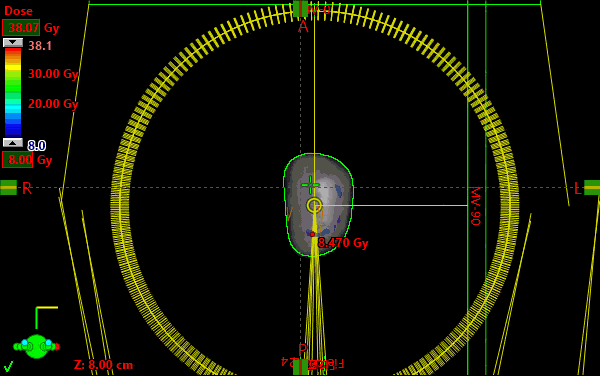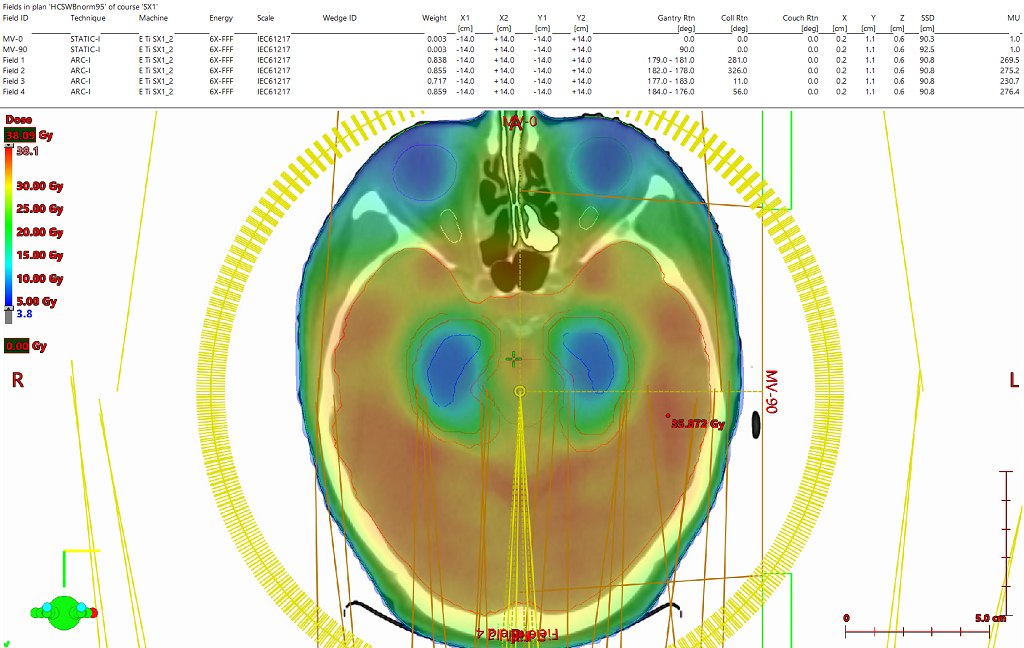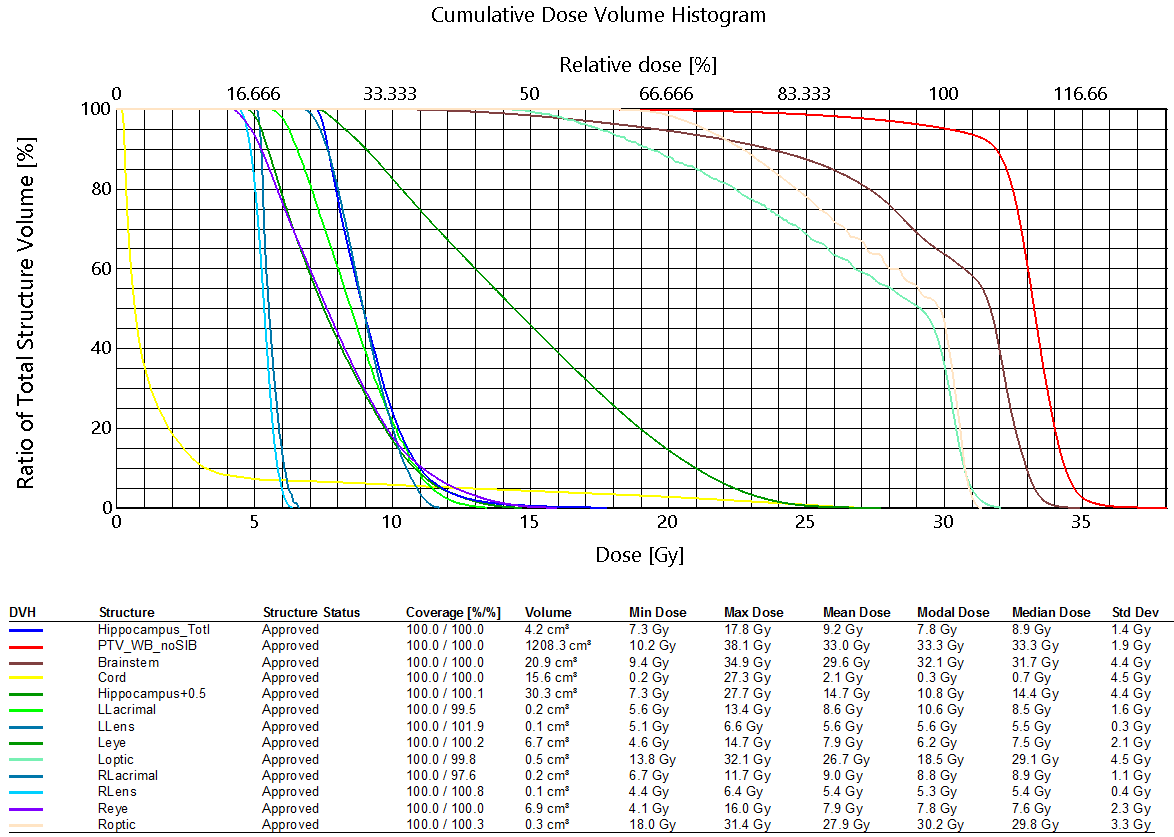Whole brain w/ hippocampalsparing 30Gy (NRG-CC001) [RP (HSWBv2)]
VMAT SX1
 |
 |
 |
Name (ID): AAMD2015, HCSWB_SIB (AAMD2015)
Plan or PlanSum ID: HCSWBnorm95
| Structure ID | Structure Code | Patient Structure | DVH Objective | Evaluator | Variation | Priority | Met | Achieved |
| PTV_WB_noSIB | PTV_WB_noSIB | V30.0Gy[%] | >=95 | 90 | Goal | 95.11 % | ||
| PTV_WB_noSIB | PTV_WB_noSIB | D98.0%[Gy] | >=26 | 25 | Goal | 26.325 Gy | ||
| PTV_WB_noSIB | PTV_WB_noSIB | D2.0%[Gy] | <=37.5 | 40 | Goal | 35.127 Gy | ||
| HIPPOCAMPUS_TOTL | Hippocampus_Totl | D0.03cc[Gy] | <=16 | 17 | Goal | 14.334 Gy | ||
| HIPPOCAMPUS_TOTL | Hippocampus_Totl | Min[Gy] | <=9 | 11 | Goal | 7.258 Gy | ||
| CHIASM | Chiasm | D0.03cc[Gy] | >=37.5 | 30 | Variation | 30.671 Gy | ||
| LOPTIC | Loptic | D0.03cc[Gy] | <=30 | 37.5 | Variation | 30.942 Gy | ||
| ROPTIC | Roptic | D0.03cc[Gy] | <=30 | 37.5 | Variation | 30.780 Gy | ||
| LLENS | LLens | D0.03cc[Gy] | <=6 | 10 | Goal | 5.858 Gy | ||
| RLENS | RLens | D0.03cc[Gy] | <=6 | 10 | Goal | 5.667 Gy | ||
| LEYE | Leye | Mean[Gy] | <=8 | 15 | Goal | 7.876 Gy | ||
| REYE | Reye | Mean[Gy] | <=8 | 15 | Goal | 7.924 Gy | ||
| BRAINSTEM | Brainstem | D0.03cc[Gy] | <=34.5 | 37.5 | Goal | 34.305 Gy | ||
| LLACRIMAL | LLacrimal | Mean[Gy] | <=10 | 20 | Goal | 8.616 Gy | ||
| RLACRIMAL | RLacrimal | Mean[Gy] | <=10 | 20 | Goal | 9.013 Gy | ||
| CORD | Cord | D0.03cc[Gy] | <=30 | 37.5 | Goal | 26.186 Gy |
Four (4) arc VMAT technique was chosen and 4 almost complete arcs were used. Each arc used a different start and stop angle (offset by 1 degree) to stagger the available control points throughout each arc rotation and unique collimator rotations per field were automatically generated utilizing the arc geometry tool. The inverse planning optimizer was populated utilizing the free hippocampal sparring RapidPlan HSWBv1 model below.
This 2016 version of the Rapidplan model is only still recommened for Eclipse V13.X users. Newer version users should see the HSWBv2 model below and sample it's performance at the VMAT2 toggle above.
No changes were made to the objectives, only the model documentation suggested pausing and unpausing of the VMAT optimizer at each MR sub-step. The RapidPlan model was designed for use with a non-coplanar 4 arc beam arrangement with 2 vertex arcs, but this beam arrangement proved not to be critical as the resulting coplanar plan created here is of high clinical quality (if perhaps a bit less homogeneous than a plan created with a non-coplanar beam arrangement).
Even though the RapidPlan model was tuned to provide maximal hippocampal sparring, beyond what is requested by the NRG-CC001 protocol, this plan proved impressive in this regard reaching a minimum hippocampal dose almost 2Gy below what is requested by the protocol. This machine’s ability to produce plans with such aggressively spared hippocampi structures could be attributable to the two-stage stacked and staggered MLC with very low interleaf leakage.
Whole brain plan to 30 Gy. Hippocampal sparing is achieved with a 7-8 Gy dose to the hipoccampal areas. Nothing remarkable otherwise. Good homogeneity. This is a clinically acceptable plan.
|
Supporting Documents |
Download RapidPlan Model |
DICOM patient export |
|
(recommended) |
||
|
|
||
|
|
Any reference to a "plan study" are simply what the organizers call each case and may not be a "study" in the FDA sense as they may not have been published in a peer reviewed journal.
Varian does not provide medical advice and these are illustrative examples only.
Leading plans by expert planner. Your results may vary.
FOR EDUCATIONAL AND SCIENTIFIC EXCHANGE ONLY – NOT FOR SALES OR PROMOTIONAL USE.